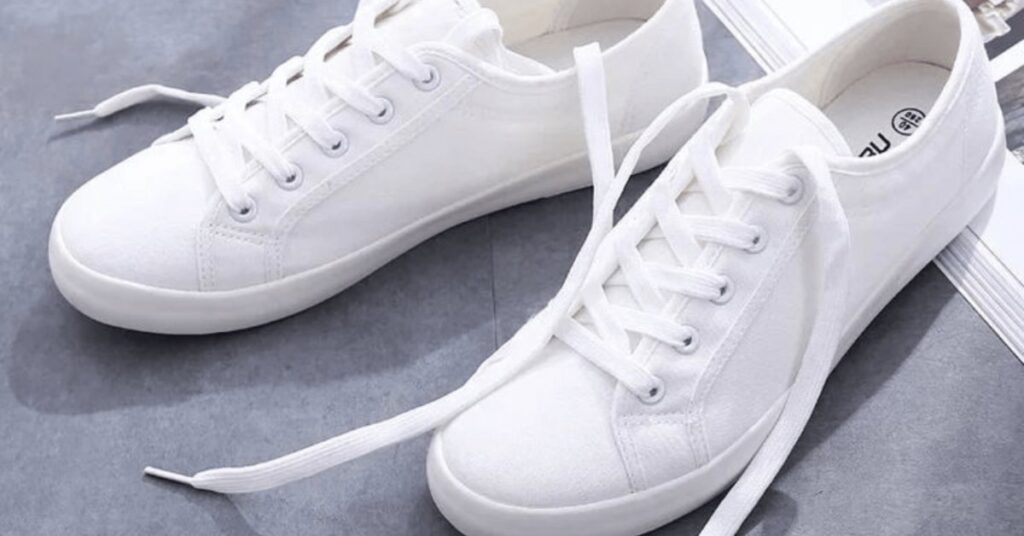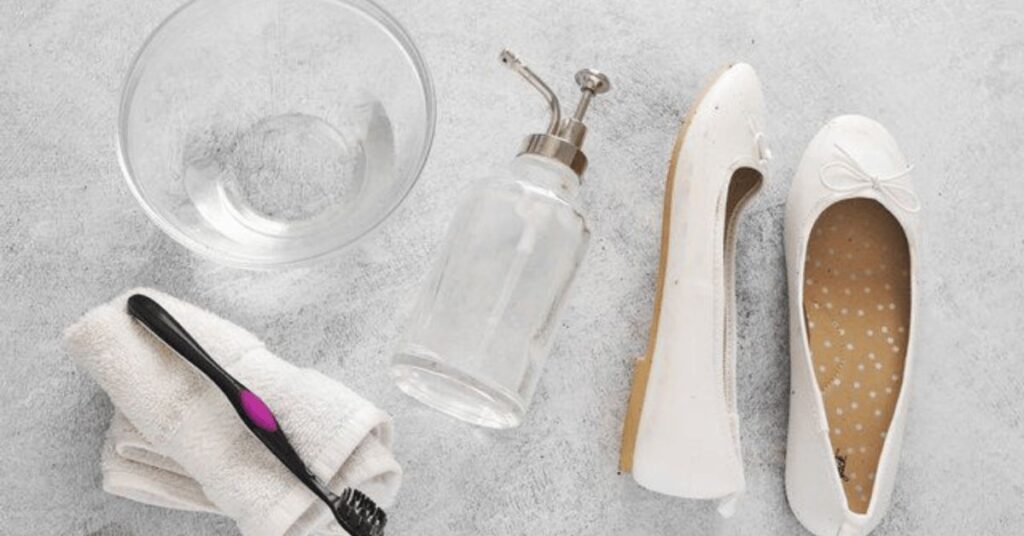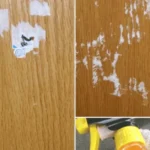To clean white shoes, use baking soda and vinegar for canvas, soapy water for leather, laundry detergent for mesh, bleach for tough stains or laces, and toothpaste for general grime. Scrub gently with a toothbrush and let shoes air dry.
How to Clean White Shoes
Keeping your white shoes looking bright and fresh isn’t just about tossing them into a machine or dryer—that can cause damage to your favorite sneakers or delicate footwear. Instead, follow approved and tested strategies tailored to your shoe’s materials, whether canvas, leather, or mesh. These step-by-step cleaning methods help tackle scuffs, stains, and dirt, restoring that clean look we all love. From shoelaces to soles, properly washing them can revive even the most dingy pairs sitting in your closet. Your white shoes are a timeless staple, and with the right care, they’ll keep looking great through every season.
What You’ll Need:
- Dirt picking tools
- Toothbrush
- Warm Bleach water for your laces
- Soft and hard bristle brush
- Warm water
- A cleaning tray or towel
- Socks or a shoe form to place inside of your shoe to keep its shape while cleaning.
- Microfiber towels
- Shoe cleaning solution or soapy water
- Nitrile gloves
Get Prepped
Getting ready with the right tools and setup is key to cleaning white shoes effectively. A proper prep routine helps avoid mess and ensures every part of the shoe is properly cleaned.
- Lay down a towel or set a tray to catch any dirt, debris, or water during the process.
- Wear a glove and begin removing the laces from the shoes, then place them in a bowl with bleach and water. Gently massage and let them soak.
- Use a soft bristle brush to start knocking off loose dust and grime from the upper.
- Switch to a hard bristle brush for scrubbing the rubber outsole, especially tough, dirty spots.
- Insert socks or a form into the shoe to maintain its shape and provide support while cleaned.
- For smaller areas, use a toothbrush to reach tight corners and edges.
Step 01 | Deep Surface Refresh
Start by removing the shoelaces and setting them aside for separate cleaning. This helps focus on the surfaces of the shoes without interference and ensures both parts get proper attention.
Prepare all necessary items and begin by knocking the soles together to loosen large bits of mud, dirt, or stuck debris. A soft-bristled brush works well to gently go over the outer edges, tongues, and heel areas.
Pay special attention to nooks and corners where grime may settle. Carefully brush these spots to get rid of hidden buildup and give the entire surface a consistent, fresh look.
Step 02 | Clean the Shoe Surfaces
Start by mixing vinegar and baking soda in a small container to create a paste. This solution works well for cleaning the surface of the shoes, especially when applied with an old toothbrush. Gently dip the brush into the paste and apply it directly to the shoes. Focus on stubborn stains and any yellow spots, as the paste is great for lifting them.
Once the paste is applied, let it sit for a few minutes while the paste dries and works its magic. Be sure to keep the shoes away from sunlight during this time, as direct exposure can cause discoloration. After letting it air-dry, brush off the hardened paste with a soft cloth or paper towel.
If any residue remains, simply wash the shoes with warm water to remove it. This helps restore the shoe to its original cleanliness. If there are any parts that are still stained, repeat the spot-cleaning process, using a bleach pen for extra precision.
Always place the shoes in a warm, dry area to finish drying. Avoid exposing them to harsh sunlight, as this can cause the paste to turn the shoe’s color or weaken the material. Once dry, your shoes should look fresh and ready to wear.
Step 03 | Clean the Soles
To clean the soles, start by using a wet sponge or an eraser to remove dirt and scuffs. Simply follow the instructions provided for the sponge and gently scrub all the surfaces. For the undersides of the soles, use a soft-bristled brush or an old toothbrush with mild detergent to scrub away any stubborn marks, making sure to get into all the crevices and keep them fresh.

Washing the Outsole
Start by wetting your hard bristle brush with warm water and applying a cleaning solution. Use the brush to scrub the outsole, focusing on the grooves and edges to remove dirt.
For hard-to-reach areas, use a dirt pick to clean thoroughly. Once done, wipe the shoe with a microfiber cloth and move on to the upper when the outsole is clean.
Washing the Upper
Start by wetting a soft bristle brush with warm water and apply a small amount of dish soap or cleaning solution. Gently scrubbing the upper part of the shoe, which covers the foot, helps lift dirt, smudges, and deep stains while protecting the material’s condition.
Use a toothbrush for specific, harder-to-reach areas and go over them gently. As you clean, wipe the surface with a microfiber towel to remove loosened dirt and soap. Take care not to wear the fabric while maintaining a clean finish.
Washing the Laces
Start by picking up your laces and giving them a good wring to get rid of all the dirt stuck from your sneakers. Drop them into a bleach and water mix for a deep clean that helps them look dazzling again and lets your shoes fit snugly and securely like new.
Next, lay a microfiber cloth or towel on your tray or any flat base, then place your laces on top. Fold the fabric over and gently press down to squeeze the excess water out—a small but key step to restoring that cherry on top of your white shoe look.
How to Clean White Soles
To clean white soles, dampen a clean cloth and gently rub the surface using a bit of mild soap or cleaning solution. For tougher marks or grime, a sponge with texture works well to lift off dirt without harming the sole.
Reach into the grooves and edges using a dirt remover tool or even your fingernail wrapped in cloth to dislodge trapped debris. Once clean, pat the area with a dry towel and let the shoes rest in a well-ventilated spot.
Let Them Air Dry
After cleaning, take your shoes out and place them in a room at a moderate temperature to dry. Keep them away from direct sunlight, and while they dry, feel the shoes and check the process. Once they’re dry, ensure the laces are near the final step, and they’re ready to wear.
How to Clean White Leather Shoes
Follow these steps to restore and maintain the fresh look of your leather items.
Clean Shoes with Soapy Water
After removing the shoelaces, mix a few drops of liquid soap in a cup of warm water. Dip a dry toothbrush into the soapy solution and gently scrub the shoes, focusing on loose dirt and stains.
Clean Soles and Let Dry
After cleaning your shoes, use an eraser sponge to remove any scuffs or stains from the soles. Then, grab a damp cloth to wipe the shoes and stuff them with white paper towels to absorb any remaining moisture inside. Make sure they maintain their shape as they dry completely, and let them air out until they’re ready for wearing.

How to Clean White Canvas Shoes with Baking Soda & Vinegar
Try this simple method to keep your white canvas shoes—like Converse or Vans—looking clean and bright.
Remove Loose Dirt
Start by untying and removing the shoelaces to easily access all parts of the shoe, including the tongue, edges, and outer soles. Take the shoes outside and knock the bottoms together to loosen large chunks of caked-on dirt and mud, which often stick underneath or around the rubber areas.
Use a dry, soft-bristled toothbrush or a small brush to scrub the remaining dirt, especially around tricky spots like the tongue and edges. Gently brush in circles over the surface to lift up any dirt that’s still clinging, and be sure to give extra attention to the soles and outer areas for a proper pre-clean.
Combine Baking Soda and Vinegar to Form a Cleaning Paste
Mix baking soda and vinegar in a bowl to create a thick paste, then dip a toothbrush into the mixture and softly scrub it over the white shoes, making sure to apply it on all visible stains, including grass, blood, or other stubborn spots that won’t budge.
Allow the paste to harden and become completely dry, then brush off the dried bits and wipe the remainder with a soft cloth or paper towel. For deeper stains, a bleach pen can be used; after a wait of a few minutes, rinse with hot water and liquid detergent to fully remove the solution.
How to Clean White Mesh Shoes with Laundry Detergent
Brush Away Dirt
Cleaning white shoes, especially those made from mesh or canvas, requires a gentle touch to avoid damaged fabric, which can be delicate and easily snagged. Using a soft-bristled dry toothbrush, brush gently to remove excess dirt from the shoes, focusing more on mesh areas that are softer than sturdier fabrics like canvas. It’s best to do this outside to shake off loose particles during the cleaning process.
Clean Shoes with Soapy Water
To create a soapy solution, add a small amount of liquid laundry detergent to a bowl of warm water, then apply it using a soft cloth in circular motions for cleaning shoes. Periodically rinse the cloth to avoid spreading stains or dirt across the fabric, and for stubborn spots like grass or ground-in marks, use a toothbrush or bleach pen to gently scrub the mesh surface.
Rinse Shoes and Let Dry
When rinsing mesh shoes, avoid submerging them in water, as it can damage the interiors or affect their shape. Instead, use a clean damp cloth to wipe the exterior of the shoes, and fill them with white paper towels to help them retain their shape. Let the shoes air-dry completely before wearing.
How to clean white suede shoes
To clean white suede shoes, it’s important to understand their delicate nature. Use the right tips to remove tough stains without damaging the suede. Brushing or wiping wet suede may push the stains deeper, making them more difficult to remove.
Expert tip: Avoid soaking suede—gently dampen the surface instead to prevent damage.
Always handle white suede shoes gently, as the nature of the material can make it impossible to fix stains if not done correctly. By following proper tips, you can effectively clean your stylish shoes without ruining their delicate appearance.
What you’ll need:
- Suede cleaner, white vinegar, or rubbing alcohol
- Suede eraser or eraser sponge
- Suede brush or old toothbrush
- Soft cloth
Step 01 | Remove dirt and debris
Removing the laces, then lightly rub the suede using a suede brush or toothbrush helps pull out loose dirt and debris. A soft, dry cloth can be a handy alternative if a proper suede brush isn’t available.
Use a gentle, side-to-side motion to lift dirt from the fibers without damaging the texture. Suede’s magnet-like nature means regular brushing keeps the shoes looking clean and fresh.
Step 02 | Rub out marks
A specialized eraser from a shoe store, a sponge, or even a pencil eraser can scrub off marks and stains from suede surfaces using a side-to-side motion.
Be sure not to apply heavy pressure, as it can damage the fibers and affect the suede’s texture.
Step 3 | Remove stains
For serious stains on suede shoes, use a soft cloth and suede cleaner, or opt for rubbing alcohol or white vinegar as substitutes. Lightly damp the cloth but avoid a full drench.
Use circular motions and gentle massaging to treat the stain and repeat the process until it’s removed, keeping every movement light and controlled.
How to clean white trainers
To protect your white shoes from stains, water marks, and dirt, apply a protective spray on leather, nubuck, or suede. For canvas shoes, rub a clear candle on the upper and use a hairdryer to melt the wax—this helps with build-up and waterproofing your boots or trainers.
When heels, toes, or heeled shoes get scuff marks or look unsightly, use good quality white nail polish to cover and start hiding the smaller scratches. It can keep damage from becoming permanent and even prevents stretching in worn shoe areas.
How to Clean White Shoes With Soap and Water
Mix a small amount of liquid soap with warm water to make a gentle cleaning solution, then dip a soft cloth or toothbrush into it and gently scrub the surface of the white shoes to lift dirt and surface stains. Avoid over-saturating the material, especially on mesh or delicate fabrics.
Rinse the cleaned areas using a clean, damp cloth, making sure not to soak the shoes. Use paper towels to fill the insides and help maintain their shape while they air-dry completely away from direct heat or sunlight.
How to Clean White Shoes With Baking Soda
Mix one tablespoon of baking soda, one of white vinegar, and a bit of warm water to make a cleaning paste. Use a toothbrush to apply it onto the shoes, scrubbing in small circles to lift stains and dirt—then let it sit and harden for a few hours.
Once the paste is dry, brush off the residue, then wipe with a damp cloth to clean. This method helps lift tough spots and refresh the look of white shoes without harsh chemicals.
Baking Soda and White Vinegar
Mix baking soda with white vinegar in a bowl to form a thick paste, then dip a toothbrush in the mixture and gently apply it over the shoes, scrubbing to remove dirt and stains. Allow it to harden, then wait a few minutes until it’s completely dry.
Brush off the bits, then wipe clean with a soft cloth or paper towel. For stubborn spots, use a bleach pen, rinse with hot water, and finish with liquid detergent to restore the shoes.

How to Clean White Shoes With White Vinegar
Mix white vinegar with a bit of baking soda to create a powerful paste, then gently apply the mixture onto the shoes using a toothbrush. Let it dry completely, then brush away residue, dirt, and surface stains.
For stubborn marks, dab some vinegar onto a cotton ball or cloth, wait a few minutes, and then wipe clean. This method helps remove even the most difficult spots and restores white shoes to a fresh look.
How to Clean White Shoes With Lemon Juice
Mix lemon juice with baking soda to form a natural paste, then apply it to white shoes using a cotton ball or cloth. Let it sit for several minutes to break down surface stains and dirt.
This natural cleaner works gently to remove buildup while leaving a fresh, bright finish. Afterward, wipe off the paste and allow the shoes to air dry fully for best results.
How to Clean White Shoes With Bleach
To clean white shoes effectively, dilute liquid bleach by mixing 1 part bleach with 4 parts water. Use a bleach pen for small, dark stains or apply the solution with a toothbrush to gently scrub the shoes. After scrubbing, rinse thoroughly, let the shoes dry, and wear them brightened and refreshed, using protective gloves to avoid contact with the bleach.
How to Clean White Shoelaces with Bleach
Remove and Soak Shoelaces
To clean white shoelaces, remove them from the shoes and place them in a white mesh lingerie bag. Soak the bag in a bleach solution (mixing 3 tbsp of bleach for every gallon of water) for five minutes, using a small plate to keep the bag submerged if necessary.
WARNING: If you use a mesh laundry bag for this step, avoid reusing it with your regular laundry to prevent accidental bleaching.
Wash Laces
Take the laces out of the bleach solution, toss them in the washing machine with regular detergent, and let them air dry afterward.

How to Clean White Shoes With Toothpaste
To clean white sneakers quickly, toothpaste can be a great solution. Use an all-white toothpaste (preferably with baking soda) and a toothbrush to gently scrub the entire surface of the shoes. After scrubbing, let the shoes sit for about 15 minutes to allow the toothpaste to work. Once dried, take a damp washcloth and wipe away the dried toothpaste, leaving your sneakers looking fresh and clean.
How to Clean White Shoes With Micellar Water
To clean white shoes, micellar water works wonders. This gentle solution, often used to cleanse the skin, is also effective on leather, suede, and rubber shoes. The micelles in micellar water, which consist of purified water, moisturizers, and cleansing compounds, pull dirt and oil from the surface of your shoes, leaving them clean and white. Simply apply it to a soft cloth and wipe your shoes—it’s a quick, well-balanced method for a spotless finish.
How to Clean White Shoes With a Magic Eraser
To clean your white leather shoes with a Magic Eraser, simply dip the tool in water and gently scrub away any grime or stains from the leather upper and sole. The Magic Eraser is great for removing stubborn dirt, just like it does with your bathtub. Make sure to clean the entire surface for a fresh, spotless look!
Importance of Regular Maintenance and Professional Cleaning
To maintain white shoes, regular wiping, using a shoe cleaner, and drying them properly is crucial. Even with great care, they may start to yellow over time, so professional cleaning services like Shoe wash Supremes’ Sole Whitening are a helpful option. By incorporating these maintenance tips into your shoe care routine, you can keep them looking fresh longer.
How to clean white shoes without turning them yellow
To avoid your white shoes turning yellow, never leave them under direct or prolonged exposure to sunlight. The ultraviolet rays can trigger a chemical reaction with leftover detergent or shoe dyes, causing discoloration. Always dry shoes in a clean area that isn’t exposed to the sun.
After cleaning, stuff your shoes with paper towels to absorb excess moisture and help them dry evenly. Speed up the drying process using a fan, which helps avoid buildup of excess dampness and reduces yellowing while preserving the brightness of your white shoes.
What is Oxidation?
Oxidation occurs when a substance reacts with oxygen, leading to the loss of electrons. This process often results in discoloration, especially in white shoes, where the rubber soles are most affected. Over time, the interaction of the element with oxygen causes visible changes, turning the soles yellowish or dull.
Limitations and Potential Damage from DIY Solutions
While DIY solutions are useful, they aren’t always a one-size-fits-all fix for whitening shoes. For instance, they might not be strong enough to tackle stubborn stains and work best on light discoloration or fresh stains. Additionally, some ingredients can be too harsh, leading to potential damage to the materials over time. Moreover, results can vary depending on the method and the type of shoe material, making it clear that professional shoe care services may be the best option for consistent and thorough results.
Frequently Asked Questions
For effective cleaning of white leather shoes, avoid harsh chemicals and use gentle solutions like micellar water, a paste of baking soda and vinegar, or a magic eraser. These help scrub away tough stains without damaging the surface. Always rinse with water and let the shoes dry naturally for best results.
Even the best whitening tricks won’t save your shoes once they turn soiled or look drab after constant walking and running. A good rule is to replace your pair every 300–500 miles, especially if they’re no longer offering support or style. If your once trusty kicks have lost their charm, it might be smarter to purchase a new set rather than keep scrubbing endlessly.
Freshly washed white shoes often turn yellow due to sun exposure, trapped cleaning products like detergent, or sweat and dirt getting embedded in the fabric or leather. Daily wear and tear only speed up the yellowing, especially when the products aren’t rinsed out properly.
To clean fabric shoes, use a heavily-diluted bleach mixture of five parts water and one part bleach. Apply the solution with a rag on stains but avoid soaking the shoes. Be cautious though, as using bleach on white fabric shoes might cause them to yellow, so it’s best to test this method carefully.
When using baking soda as a paste to clean white shoes, let it sit for about three to four hours until it hardens. Once hardened, wipe it off with a soft cloth rag. To remove any leftover residue, dampen the cloth with warm water and wipe again for a clean finish.




